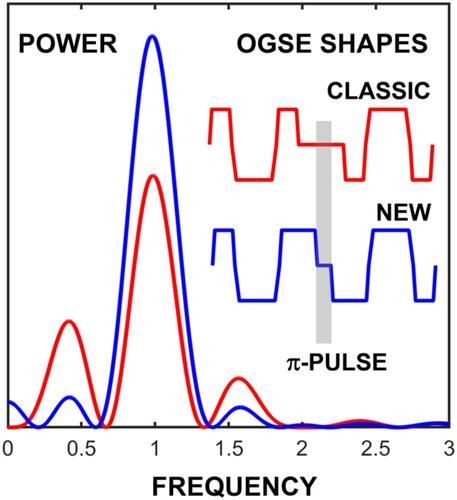当前位置:
X-MOL 学术
›
NMR Biomed.
›
论文详情
Our official English website, www.x-mol.net, welcomes your feedback! (Note: you will need to create a separate account there.)
Improved gradient waveforms for oscillating gradient spin‐echo (OGSE) diffusion tensor imaging
NMR in Biomedicine ( IF 2.9 ) Pub Date : 2020-10-29 , DOI: 10.1002/nbm.4434 Franciszek Hennel 1 , Eric Seth Michael 1 , Klaas P Pruessmann 1
NMR in Biomedicine ( IF 2.9 ) Pub Date : 2020-10-29 , DOI: 10.1002/nbm.4434 Franciszek Hennel 1 , Eric Seth Michael 1 , Klaas P Pruessmann 1
Affiliation

|
The dependence of the diffusion tensor on frequency is of great interest in studies of tissue microstructure because it reveals restrictions to the Brownian motion of water molecules caused by cell membranes. Oscillating gradient spin‐echo (OGSE) sequences can sample this dependence with gradient shapes for which the power spectrum of the zeroth moment is focused at a target frequency. In order to maintain the total spectral power (ie the b‐value), oscillating gradient amplitudes must grow with the frequency squared. For this reason, OGSE applications on clinical MRI scanners are limited to low frequencies, for which it is difficult to obtain a narrow frequency bandwidth of the gradient moment in a useful echo time. In particular, the commonly used pair of single‐period trapezoidal‐cosine pulses separated by a half‐period produces significant side lobes away from the target frequency. To mitigate this effect, improved OGSE waveforms are proposed, which reduce the gap between the two gradient pulses to the minimum duration required for the refocusing RF pulse. Additionally, a slight deviation from the periodicity of the waveforms is proposed in order to permit using the maximum slew rate of the gradient system for all lobes of trapezoidal waveforms while maintaining advantageous spectral properties, which is not the case for the currently used OGSE sequences. Numerical calculations validate these changes, showing that both modifications significantly narrow the gradient moment power spectrum and increase the contribution of its main lobe to the b‐value, thus improving the specificity of the measurement. The utility of the new shapes is demonstrated by diffusion tensor measurements of human white matter in vivo over the range of 30‐75 Hz with a b‐value of nearly 1000 s/mm2, using a high‐performance gradient insert. However, the improvement should increase the sampling precision of OGSE experiments for all gradient systems.
中文翻译:

用于振荡梯度自旋回波 (OGSE) 扩散张量成像的改进梯度波形
扩散张量对频率的依赖性在组织微观结构的研究中非常有趣,因为它揭示了由细胞膜引起的水分子布朗运动的限制。振荡梯度自旋回波 (OGSE) 序列可以使用梯度形状对这种依赖性进行采样,其中零阶矩的功率谱集中在目标频率上。为了保持总频谱功率(即b值),振荡梯度幅度必须随着频率的平方而增长。因此,OGSE 在临床 MRI 扫描仪上的应用仅限于低频,因此很难在有用的回波时间内获得梯度矩的窄频带宽。特别是,常用的一对由半周期分隔的单周期梯形余弦脉冲会产生远离目标频率的显着旁瓣。为了减轻这种影响,提出了改进的 OGSE 波形,将两个梯度脉冲之间的间隙减小到重新聚焦 RF 脉冲所需的最小持续时间。此外,建议与波形的周期性略有偏差,以便允许对梯形波形的所有波瓣使用梯度系统的最大转换速率,同时保持有利的频谱特性,而当前使用的 OGSE 序列并非如此。数值计算验证了这些变化,表明这两种修改都显着缩小了梯度矩功率谱,并增加了其主瓣对b值,从而提高测量的特异性。新形状的实用性通过使用高性能梯度插入物在 30-75 Hz 范围内对b值接近 1000 s/mm 2 的体内人体白质进行扩散张量测量来证明。然而,改进应该提高所有梯度系统的OGSE实验的采样精度。
更新日期:2021-01-04
中文翻译:

用于振荡梯度自旋回波 (OGSE) 扩散张量成像的改进梯度波形
扩散张量对频率的依赖性在组织微观结构的研究中非常有趣,因为它揭示了由细胞膜引起的水分子布朗运动的限制。振荡梯度自旋回波 (OGSE) 序列可以使用梯度形状对这种依赖性进行采样,其中零阶矩的功率谱集中在目标频率上。为了保持总频谱功率(即b值),振荡梯度幅度必须随着频率的平方而增长。因此,OGSE 在临床 MRI 扫描仪上的应用仅限于低频,因此很难在有用的回波时间内获得梯度矩的窄频带宽。特别是,常用的一对由半周期分隔的单周期梯形余弦脉冲会产生远离目标频率的显着旁瓣。为了减轻这种影响,提出了改进的 OGSE 波形,将两个梯度脉冲之间的间隙减小到重新聚焦 RF 脉冲所需的最小持续时间。此外,建议与波形的周期性略有偏差,以便允许对梯形波形的所有波瓣使用梯度系统的最大转换速率,同时保持有利的频谱特性,而当前使用的 OGSE 序列并非如此。数值计算验证了这些变化,表明这两种修改都显着缩小了梯度矩功率谱,并增加了其主瓣对b值,从而提高测量的特异性。新形状的实用性通过使用高性能梯度插入物在 30-75 Hz 范围内对b值接近 1000 s/mm 2 的体内人体白质进行扩散张量测量来证明。然而,改进应该提高所有梯度系统的OGSE实验的采样精度。



























 京公网安备 11010802027423号
京公网安备 11010802027423号